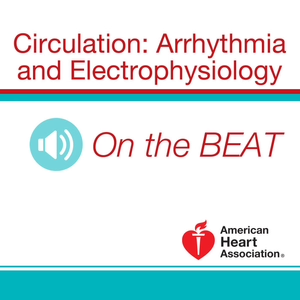
Circulation: Arrhythmia and Electrophysiology November 2019 Issue
Circulation: Arrhythmia and Electrophysiology On the Beat11/19/19 • 15 min
Dr Paul Wang: Welcome to the monthly podcast, On the Beat, for Circulation: Arrhythmia and Electrophysiology. I'm Dr Paul Wang, editor in chief, with some of the key highlights from this month's issue.
In our first paper, Leroy Joseph and associates examined whether an increase in dietary saturated fat could lead to abnormalities of calcium homeostasis and heart rhythm, by an NADPH oxidase 2, NOX2-dependent mechanism.
In mice on high fat diets, they found that saturated fat activates NOX, whereas polyunsaturated fat does not. The high saturated fat diet increased repolarization heterogeneity in ventricular tachycardia, VT inducibility in perfused hearts. Pharmacologic inhibition or genetic deletion of NOX2 prevented arrhythmogenic abnormalities in vivo during high saturated fat diet and resulted in less inducible VT. On the other hand, high saturated fat diet activates calcium calmodulin dependent protein kinase in the heart, which contributes to abnormal calcium handling, promoting arrhythmia. This work suggests that a molecular mechanism links cardiac metabolism to arrhythmia and it suggest that NOX2 inhibitors could be a novel therapy for heart rhythm abnormalities caused by cardiac lipid overload.
In our next paper, Misha Regouski and associates examined whether the relationship between endurance exercise and atrial fibrillation, or AF, is dependent on atrial myopathy. They examined six cardiac specific TGFβ1 transgenic and six wild type goats. Pacemakers were implanted in all animals for continuous arrhythmia monitoring and AF inducibility. AF inducibility was evaluated using five separate ten second bursts of atrial pacing. At baseline sustained AF greater than 30 seconds was induced with 10 seconds of atrial pacing in 4 out of 6 transgenic goats, compared to zero out of six wild type controls, P less than 0.05. No spontaneous AF was observed at baseline, three months of progressive endurance exercise up to 90 minutes at 4.5 miles per hour was performed. The authors observed that between two to three months of exercise, three out of six transgenic animals developed self-terminating spontaneous atrial fibrillation compared to zero out of six wild type animals, (P less than 0.05). There was an increase in AF inducibility in both transgenic and wild type animals during the first two months of exercise with partial normalization at three months.
These changes in AF susceptibility were associated with a decrease in circulating micro RNA 21 and micro RNA 29 during the first two months of exercise, with partial normalization three months in both transgenic and wild type animals. The authors concluded that endurance exercise appears to increase inducible AF secondary to altered expression of key profibrotic biomarkers that is independent of the presence of an atrial myopathy.
In our next paper, Seokhun Yang and associates examined whether there is an association between lifetime exposure to endogenous sex hormone, and incident atrial fibrillation, or AF, in subsequent ischemic stroke. They studied nearly five million natural postmenopausal women aged 40 years or greater without prior history of AF and with breast cancer. The primary end point was incident AF and the secondary end point was subsequent ischemic stroke once AF is developed. During the mean follow up of 6.3 years, shorter total reproductive years (<30 years) was associated with 7% increased risk of AF after adjusting for confounding variables. Adjusted hazard ratio, 1.07. Risk of AF declined progressively with every five-year increment in total reproductive years. P for trend less than 0.001. However, the prolonged, two years or greater use of hormone replacement therapy after menopause was paradoxically associated with a 3% increase in AF risk. (Adjusted ratio 1.03).
For the secondary endpoint analysis, the risk of ischemic stroke after AF development significantly decreased with each five-year increment in total reproductive years with less than 30 years as a reference. (Adjusted hazard ratio 0.93, for 30 to 34 years 0.84, for 35 to 39 years is 0.88, for 40 years or greater. P for trend less than 0.001) the authors concluded that women with natural menopause shortened lifetime exposure to endogenous sex hormone, that is, shorter total reproductive years, was significantly associated with a higher risk of AF and subsequent ischemic stroke. In contrast, prolonged exogenous hormone replacement therapy increased the risk of incident AF.
In our next paper, Stephan Hohmann and associates examine the accuracy of electrocardiographic imaging, ECGi, in a closed chest porcine model. A total of 109 endocardial and nine epicardial locations were paced in nine pigs. ECGi predicted the correct chamber of origin in 85% of atrial and 92% of ventricular sites. Lateral locations were predicted in the correct chamber more often than septal location. (97% versus 79% P=0.01) Absolute distances in space bet...
11/19/19 • 15 min
Episode Comments
0.0
out of 5
No ratings yet
eg., What part of this podcast did you like? Ask a question to the host or other listeners...
Post
Generate a badge
Get a badge for your website that links back to this episode
<a href="https://goodpods.com/podcasts/circulation-arrhythmia-and-electrophysiology-on-the-beat-94401/circulation-arrhythmia-and-electrophysiology-november-2019-issue-5066046"> <img src="https://storage.googleapis.com/goodpods-images-bucket/badges/generic-badge-1.svg" alt="listen to circulation: arrhythmia and electrophysiology november 2019 issue on goodpods" style="width: 225px" /> </a>
Copy